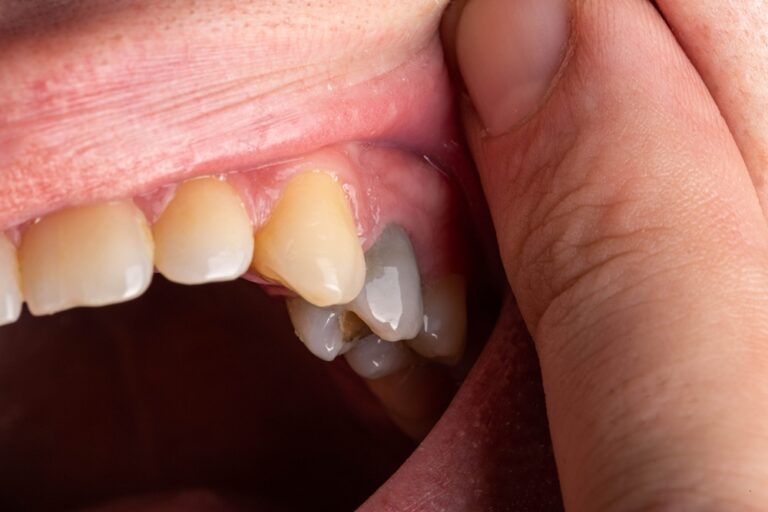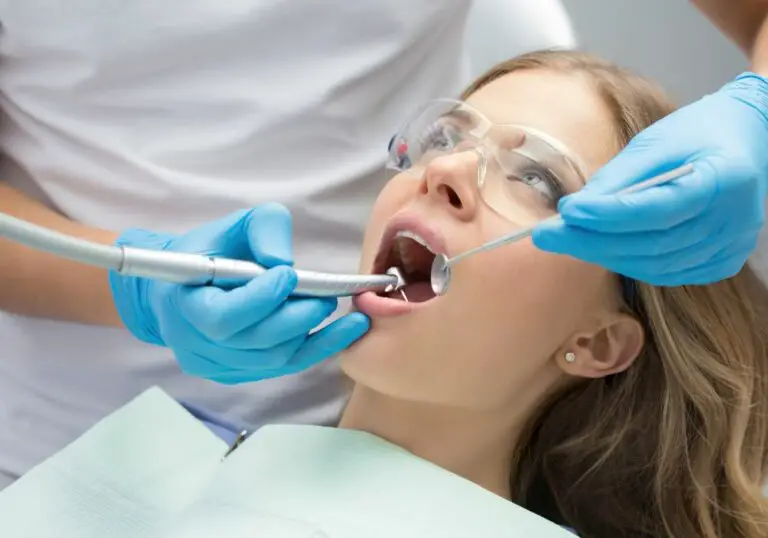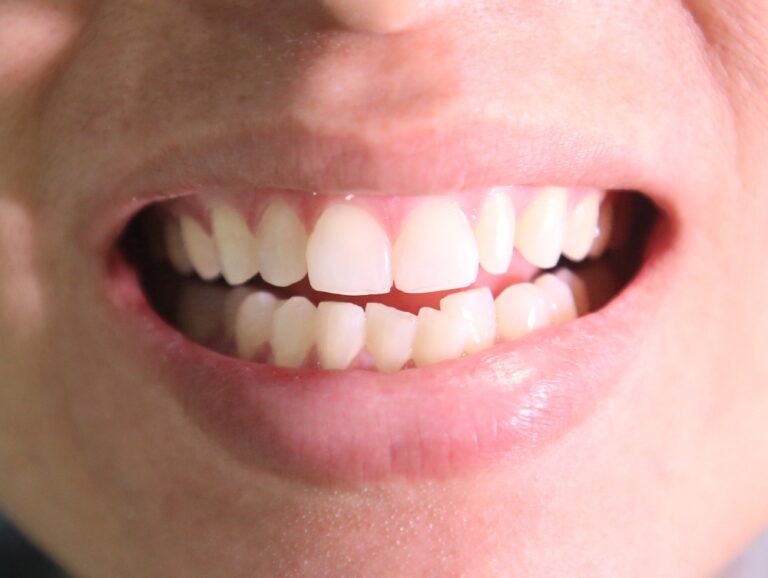What causes receding gums?
Gum recession, also known as gingival recession, occurs when the margin of the gum tissue surrounding the teeth wears away, exposing more of the tooth surface. This can happen for a number of reasons:
Gingivitis and periodontal disease
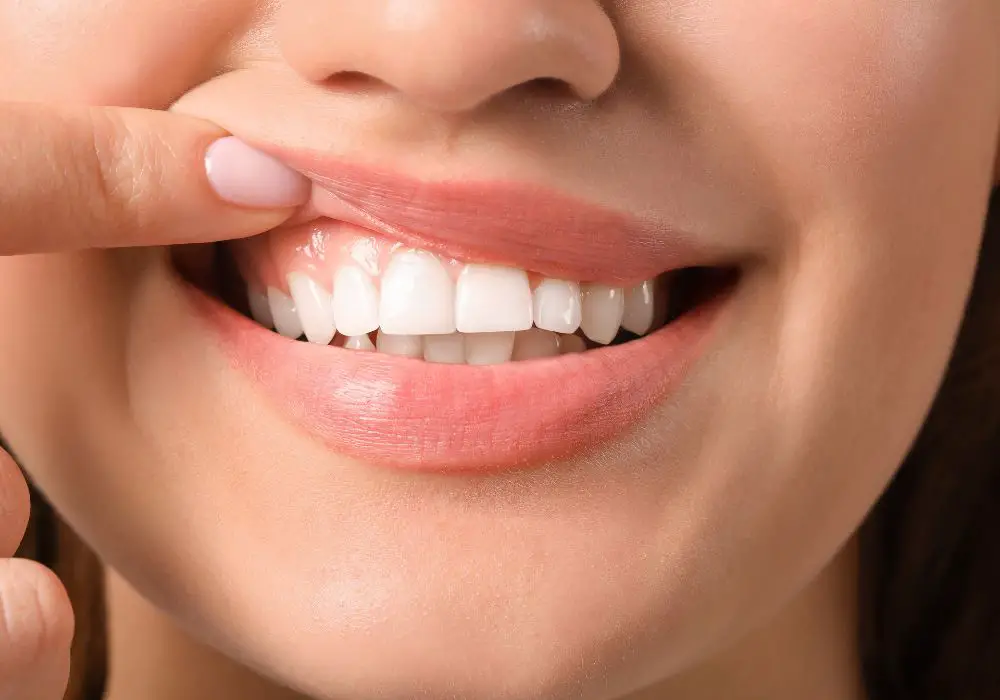
The most common cause of gum recession is due to gingivitis, an early stage of periodontal (gum) disease. When plaque (a sticky film of bacteria) builds up along and under the gumline, it can cause inflammation and irritation, making the gums swollen, reddish in color, and prone to bleeding easily when brushing or flossing.
Over time, this chronic inflammation damages the gum tissue and causes it to slowly detach from the tooth. This creates spaces known as periodontal pockets, where more bacteria can accumulate. As the disease advances, the pockets deepen and more gum tissue is destroyed, leading to loosening of the gums and eventual exposure of the tooth roots.
Aggressive brushing
Brushing too vigorously or with improper technique can eventually cause the gums to recede. Scrubbing back and forth vigorously or brushing horizontally with pressure can wear down the gum tissue. Ideally, brushing should be done at a 45-degree angle towards the gums, using gentle circular motions. Harder bristled toothbrushes may also irritate and traumatize the gums over time, causing sensitivity and recession.
Smoking and tobacco use
Smoking and chewing tobacco have been strongly linked with higher rates of gum disease and accelerated gum recession. The multitude of toxins and chemicals in tobacco products can irritate and inflame the gum tissue. They also suppress the immune system, restrict blood flow, and slow down the healing response.
Additionally, the nicotine causes gum tissues to become more permeable and prone to bacterial invasion. Smokers tend to have much more tartar and plaque buildup as well, which exacerbates irritation of the gums. The stains can also make gum issues harder to recognize visually.
Clenching and grinding teeth
People who have a habit of forcefully clenching, grinding, or chomping their teeth are at higher risk for increased gum recession. The excessive forces exerted during these behaviors can cause teeth to move and shift out of alignment, often putting more pressure on the gum tissue surrounding the teeth. Over time, this can definitely cause the gums to recede.
Periodontal surgery
Certain surgical procedures to treat advanced gum disease can cause recession as well. For example, gingivectomy is performed to excise excessive diseased gum tissue in order to reduce deepened periodontal pockets. This can sometimes leave areas of root exposure once healing is complete.
Orthodontic treatment
The movement and adjustment of teeth during orthodontic treatment can in some cases contribute to gum recession. Certain types of aggressive tooth alignment and prolonged pressure can create tension on the gum tissue. This is especially true if proper oral hygiene is not maintained during treatment. Inadequate bone support around the teeth can also predispose gums to recession.
Thin gingival tissue
Some people simply have thinner gum tissue genetically that is more vulnerable to recession even without inflammatory disease. Thin gingiva offers less protection for the deeper structures of the periodontium. There is a reduced barrier against the accumulation of bacteria and easier penetration of bacterial toxins.
Genetics
Research suggests that genetics play a definite role in gum recession as well. Some people may be predisposed to thinner tissue, insufficient keratinized gingiva, or gum anatomy that is more susceptible to recession. Other genetic traits related to connective tissue disorders, anti-inflammatory response, and wound healing may also influence risk.
Orthodontic tooth extraction
Extracting teeth for orthodontic purposes can potentially lead to gum recession as well. This is especially true of premolar extractions, where gums and bone may thin over time near the extraction sites. Proper treatment planning is important to avoid this consequence.
Overly aggressive gum surgery
In rare cases, gum surgery to treat periodontal disease may be too aggressively performed, removing more tissue than necessary. This can result in receding gums due to insufficient gingiva remaining to provide adequate coverage.
Why does gum recession matter?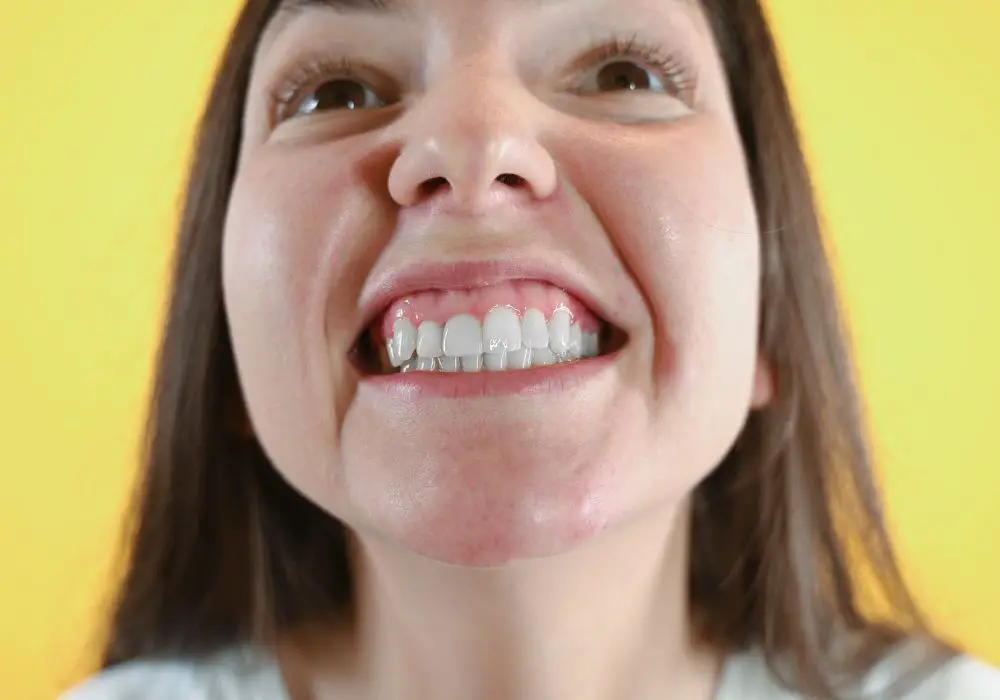
Receding gums are a concern because they can expose the tooth roots and lead to further problems:
- Tooth decay – Without the protective covering of gum tissue, exposed tooth roots become much more vulnerable to invasion by decay-causing oral bacteria. Plaque and tartar can readily adhere in these areas, leading to cavities.
- Tooth sensitivity – Once the cementum layer of the root surface is exposed due to receded gums, the openings to underlying dentinal tubules become exposed as well. This allows hot, cold, or acidic foods to stimulate the nerves and fluid within the tubules, causing sharp pains and sensitivity.
- Destruction of bone – The fibers of the periodontal ligament that attach the teeth to the surrounding jawbone can also become exposed and irritated. This bony attachment is damaged, leading to inflammation and gradual loss of the alveolar bone around the tooth.
- Tooth loosening or loss – As bone recedes away from the root surface due to infection and inflammation, teeth can become loose and even fall out in severe cases of gum disease. Mobile teeth make chewing difficult and undermine dental function.
- Poor aesthetics – Increased tooth length and dark triangular spaces between teeth due to gum recession can give your smile an unappealing “toothy” or uneven look. Receding gums accentuate the aging process.
- Root cavities – Once gum recession occurs, cavities at the gumline and beneath the gums can form. These subsurface lesions are more difficult to detect, treat, and restore.
Keeping gum recession under control is extremely important to minimize the risk of these undesirable consequences. Mild cases can often be treated and stabilized to prevent any further progression of the recession. More advanced recession may require complex grafting procedures to cover substantial areas of exposed root surfaces in an effort to regrow some of the lost gum tissue for both functional and aesthetic reasons.
Why does gum recede between teeth specifically?
Gum recession can occur anywhere around the teeth where gingival tissues have broken down, but it is most prevalent in the areas between the teeth (interproximal areas). There are several reasons this occurs frequently in these locations:
Difficult to access for cleaning
The tight embrasures and small spaces between teeth provide ideal areas for plaque to accumulate and thrive. Food debris and bacteria can readily get trapped in these interdental spaces, which are harder to access and keep clean compared to broader facial and lingual tooth surfaces. Lack of adequate cleaning in these areas allows plaque to proliferate.
Inflammation and tissue destruction
The anaerobic bacteria in plaque produce toxins that break down gum tissue fibers and cause inflammation. recurring episodes of inflammation due to poor cleaning within the gingival crevice can lead to irreversible destruction. The cellular attachment of gum to tooth is lost, resulting in recession.
Food packing
Bits of food readily get packed into the tight spots between teeth during eating and chewing. They then become impacted and are difficult to dislodge completely. This constant source of irritation inflames the localized area and promotes sustained bacterial colonization in that vulnerable site.
Weak gingival embrasures
Some individuals are prone to having weaker, thinner gum tissue between their teeth based on certain anatomical factors. The size, shape, and position of the interdental bone and contacts predispose the gum to easier breakdown and recession even with diligent oral hygiene.
High muscle attachment
A stronger, more forceful muscle attachment near the crestal bone places increased stress on the gingival margin. The pull of muscle forces during chewing can contribute to more rapid localized tissue breakdown in those high stress areas. This is often seen between back molars.
Orthodontic factors
Teeth that are crowded, crooked, or overlapped can create areas where cleaning and maintenance of gums is impaired. Physical impediments make hygiene access difficult. Orthodontic treatment to straighten and align teeth also puts tension on gum and bone tissues in between teeth.
Periodontal disease progression
As gingivitis and periodontitis progress, collagen fibers that attach the gums to the tooth surface are steadily destroyed by proteolytic enzymes from bacteria. The initial gingival inflammation increasingly destroys the gingival margin until the gum detaches from the tooth. The interdental papilla is often the first affected area.
With meticulous oral hygiene and professional care, gum recession between teeth can often be minimized or avoided altogether. But in moderate to severe cases, surgical procedures like gum grafting are usually needed to try to cover exposed roots and regrow healthy gingival tissues between teeth. The adjacent teeth provide scaffolding for the graft to adapt and heal optimally.
What are the treatment options for receding gums between teeth?
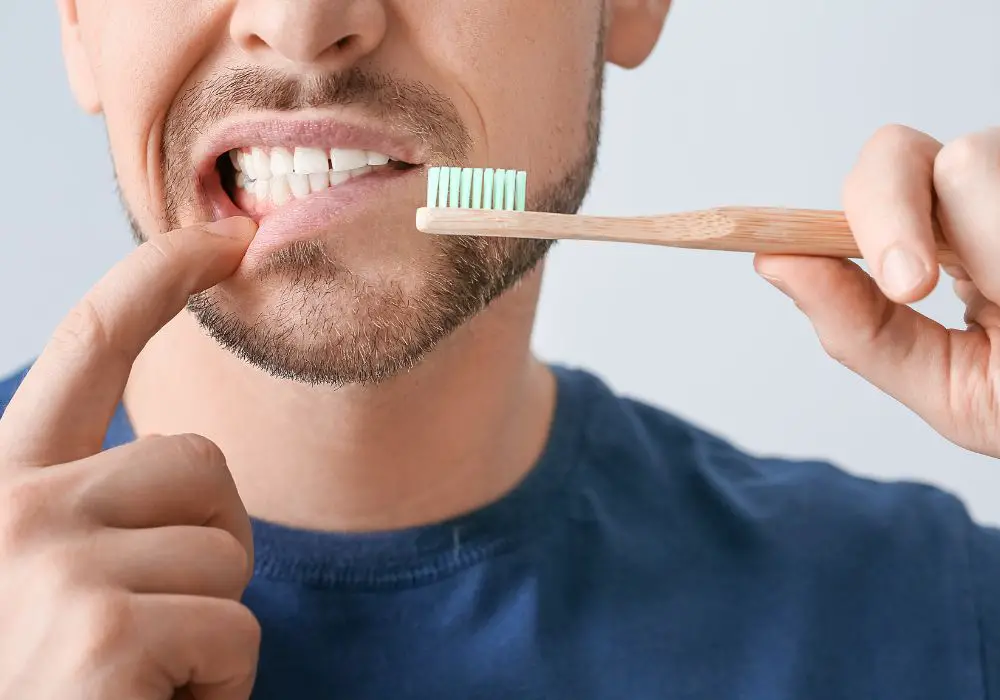
Here are some of the key treatment approaches available when gums are receding between teeth:
Improved oral hygiene
Practicing thorough daily oral hygiene is crucial both for treating and preventing receding gums between teeth. Effective hygiene to control plaque is the starting point in managing gum recession. This includes brushing properly twice per day with a soft or extra soft bristled brush. Flossing once daily with light force is critical to dislodge plaque between teeth. Using antiseptic mouthwash can reduce bacteria as well.
Professional cleanings
Getting teeth professionally cleaned and scaled by a dental hygienist every 6 months is key to controlling subgingival plaque. More frequent cleanings may be prescribed if gum disease is present. Regular cleanings allow areas like interdental spaces to be cleaned beyond what patients can do at home.
Gum tissue grafting
Grafting gingival tissue can help cover exposed tooth roots and fill in the receded areas between teeth. Tissue is commonly harvested from the palate and surgically adapted into place around the recession defects. Over several months, blood supply re-establishes in the grafted donor tissue. Proper healing provides maintained gum coverage.
Guided tissue regeneration
Using specialized barrier membranes or tissue-stimulating proteins can be combined with grafting procedures. This encourages selective regeneration of bone and gingival attachment fibers along the root surface, helping rebuild lost support around the recession.
Pinhole surgical technique
This is a minimally invasive approach where small “pinholes” are made in the gums. Special tools are used to gently loosen gum tissue and slide it down over exposed roots without grafts or sutures. Less discomfort but results can be variable.
Bone grafting
Bone grafts or tissue-derived growth factors can be placed under the gumline when significant bone loss is present near the recession. This supports regrowth of natural tissue and stabilizes improved gum coverage.
Crown lengthening
When gums have receded substantially, crown lengthening surgery reshapes gum and bone tissue to expose more natural tooth structure. This provides a better foundation for restorative work.
Laser therapy
Lasers have been utilized to remove diseased gum tissue while also promoting healing. Their value for stimulating regrowth is being researched.
Medications
Locally applied or systemic drugs that aim to reduce bacteria and inflammation may be helpful. Locally delivered antimicrobials can suppress plaque in difficult to clean recession areas.
The prognosis for stabilizing or improving gum recession between teeth depends on multiple factors: proper home care, degree of recession, health conditions, and choice of treatment. Mild cases may respond to conservative options, while advanced recession may require a combination of regenerative procedures to optimize outcomes.
At what point is gum loss between teeth serious enough to warrant treatment?
The threshold for actively intervening with gum recession treatment depends on multiple considerations:
- Mild recession (< 3 mm) – Usually just improved oral hygiene and monitoring.
- Moderate recession (3-5 mm) – Consider soft tissue grafting if aesthetics are a concern or dentin hypersensitivity is problematic.
- Severe recession (> 5 mm) – Gum grafting usually recommended to cover extensive root exposure for functional and aesthetic reasons.
- Significant bone loss visible – Grafting combined with bone regeneration techniques may be needed to rebuild lost bone support.
- Tooth mobility or drifting – Treatment is warranted to stabilize mobile teeth and prevent further deterioration.
- Tooth root caries present – Grafting and/or crown extension needed to cover exposed root and prevent decay.
- Tooth fractures – If recession contributes to fragile cusp structure, teeth require restoration.
- Severe root sensitivity – Treatment is needed if thermal or tactile sensitivity is problematic.
- Rapidly progressing – Quick intervention recommended to control recession progression.
- Aesthetic concerns – Patient desires for improved smile appearance may prompt earlier treatment.
- Systemic conditions – More aggressive regenerative therapy if impaired healing capability expected.
Discussion with a periodontist allows determining the scope of recession and necessity for surgical treatment. Mild cases can usually be observed unless specific problems arise. More severe recession often benefits from earlier intervention to limit additional damage and improve outcomes. Ultimately, the benefits vs risks of grafting procedures must be weighed given individual circumstances.
What are possible complications from gum grafting treatment?
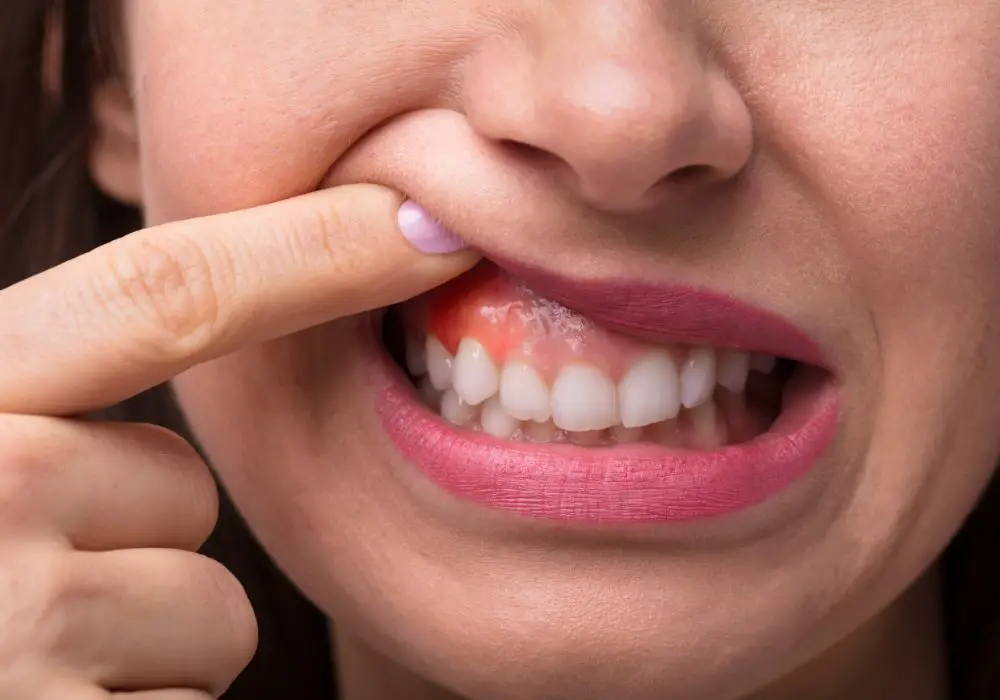
Gum grafting procedures are common for treating receding gums between teeth. However, there are some potential complications:
- Post-surgical pain – Graft sites usually involve mild to moderate pain during the healing period as tissue mends back together.
- Infection – Poor oral hygiene habits may allow bacteria to colonize and infect the grafted site, undermining success.
- Bleeding – Some minor bleeding is expected, but excessive bleeding could indicate problems like tissue necrosis or clot dissolution.
- Swelling – Moderate swelling and bruising of the gingival tissues around grafted areas is typical following the surgery.
- Loss of sensation – Grafting may lead to temporary or in some cases permanent numbness in the area worked upon.
- Tissue shrinkage – Inadequate oral hygiene after surgery can cause plaque accumulation and tissue inflammation, leading grafted gums to recede again.
- Poor color match – Initially the grafted gums may appear paler or slightly mismatched from adjacent natural gum coloration. This often improves over time.
- Graft failure – The donor tissue does not adequately adhere, integrate and revascularize into the surrounding recipient site.
- Allergic reaction – Rare localized allergic response to the source graft material or medications used.
- Tooth loss – If the underlying gum disease is extremely advanced at the time of grafting, tooth loss is still possible eventually.
- Need for re-treatment – If the initial graft fails to take, a second procedure may be necessary to attempt the process again.
Proper surgical planning, technique, and meticulous post-op oral hygiene are imperative to avoid complications and achieve optimal esthetic results from gum grafting. Follow-up appointments allow monitoring healing and quickly intervening as needed if any issues arise.
What are 5 key tips to prevent receding gums?
Here are 5 essential tips to help prevent gingival recession around the teeth:
- Brush properly – Use correct technique: soft brush, 45 degree angle to gums, gentle motions. Avoid aggressive horizontal scrubbing.
- Floss gently every day – Carefully work floss into spaces between teeth, curving it around the side of each tooth. Don’t snap floss forcefully up into gums.
- Use antiseptic rinses – Gently swish daily with antibacterial, anti-inflammatory rinses to reduce gum irritants.
- Avoid tobacco – Smoking is a major risk factor for gum recession. Quit all tobacco use.
- Get regular cleanings – Professional cleanings every 6 months (or more often if recommended) are vital for controlling subgingival bacteria.
The keys are consistently practicing thorough but gentle oral hygiene habits. Letting plaque persist leads to tissue inflammation and breakdown. Avoid tobacco for healthier gums. See your dentist and hygienist at regular intervals to detect and treat any gum issues promptly. Follow these tips diligently to help maintain stable gum levels.
Frequently Asked Questions
What does healthy gum tissue look like?
Healthy gingival tissue appears coral pink, stippled in texture, and firm to the touch. There should be no apparent redness, swelling, easy bleeding, or altered contour. Gum margins hug tightly around each tooth without detachment or recession exposing any portion of the root.
How can receded gums grow back?
Severely receded gums will not spontaneously re-grow on their own once destroyed. However, in very mild cases of early recession, meticulous plaque control and resolution of inflammation can possibly allow partial creeping attachment and natural minor regrowth of the gingival margin. Quitting smoking also facilitates this process. But for anything beyond minimal recession, soft tissue grafting is needed to successfully restore lost gum tissues.
Do receding gums mean I definitely have gum disease?
Not always, at least in the early stages. Mild gum recession can occur simply from overzealous brushing in an otherwise healthy mouth. But more commonly, receding gums are an indicator of existing gingivitis or periodontitis. The bacteria and inflammation from gum disease are what initially damage the tissue and cause the gums to detach. Receding gums in turn become even more prone to further infection and destruction. So gum recession often coincides with some level of disease.
Why do my gums bleed when I brush gently?
Bleeding from gentle brushing is most likely an early sign of gingivitis, even before severe gum recession occurs. The inflammation makes the tissues hyperemic and engorged with blood. They reach a point where even minimal stimulation can trigger bleeding. See your dentist for treatment, which will include more diligent plaque removal and possibly prescription antimicrobial rinses to resolve gum inflammation and allow healing.
How much vitamin C per day helps prevent receding gums?
Vitamin C is critical for gum health and healing capability. Most experts recommend getting at least 60-90 milligrams of vitamin

